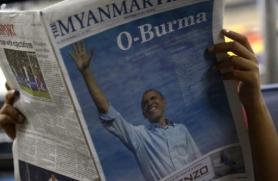What if you could visit the home of Naguib Mahfouz, Om Kolthoum, Taha Hussein and Youssef Idris all at once? Café Riche provides the converging stop where you can pay homage to Egyptian thinkers – a chain that remains almost unbroken until today.
Set to re-open within two weeks, the café that was once a regular haunt for Egypt’s intellectual elite continues to be frequented by regular customers like revered artist George Bahgoury, whose caricatures adorn the entrance room, writer Bayoumy Kandil and artist Adly Rizkallah, to name a few.
Even as you walk to the restaurant now, where a little boy announces that it is closed, visitors still come trickling in. Some point out the roof of the door or the pictures to their visitors.
With volumes to speak for its history, Café Riche is a tourist attraction in itself. The restaurant has already been the subject for masters and doctoral theses and radio and video documentaries, according it with its due honor as a literary, cultural and political think tank.
Founded in 1908, the café will commemorate its 100th anniversary this year. Rumor has it that a book on Café Riche is also in the pipelines.
The first known documentation of Café Riche, in 1914, cites Austrian Bernard Steinberg as the owner. Riche was sold to Frenchman Henri Recine within a year, who sold it to Greek business Michael Nicolapolits in 1916.
A printing press later discovered at the café is believed to be from Nicolapolits’ time, perhaps used to print leaflets during the 1919 uprisings in Egypt. A secret passageway from the room below had stairs leading to an exit on Huda Sharawi Street. Now it leads to the kitchen.
It was under Nicolapolits that Café Riche flowered into a cultural and intellectual hub for which it is renowned until today. The neighboring building was a theater that belonged to the café, and where Om Kolthoum performed at age 19 for three consecutive nights.
The café passed through two more sets of hands before it was bought by Egyptian Abdel-Malek Mikhail in 1960. It has stayed in the family since.
The son that sits at the café currently and does not wish to be named, recalls his best moment at the café was when he could flit from a conversation over literature among writers on one table to a dialogue among filmmakers and artists on another.
“It was another world, said the man about the 1960s, “not like now.
Entering into a conversation with former pilot Mohamed Tony, who took part in the 1948 War, one senses this other world, both in the content and manner of his narration.
“On Dec. 15, 1946, King Farouk raised the Egyptian flag and put the American flag down, changing the air field named John Bayn Field to King Farouk Airport. It’s now known as the Cairo International Airport.
“Our flag was green with some stars then, said Tony, adding a sprinkle with his fingers.
Tony refers to sitting at Café Riche with officers after the 1948 War among his most memorable memories. Sitting here then, one can get a first hand account of Egypt during WWII and the 1948 Arab-Israeli War.
Bayoumy Kandil, himself a writer, recollects visiting Café Riche to sit with Naguib Mahfouz. “Our generation used to listen carefully to him, to learn not only about literature, but also about life itself, he said.
For many years starting with 1963, Mahfouz had presided over literary gatherings at the café on Fridays.
The Nobel Prize winning author’s work “El Karnak (Karnak Café) is said to be based on the café and the stories he was told at Riche. Many of his characters and stories are said to be inspired by personal conversations at the café, which for a while had a board saying Karnak atop the entrance.
Late Egyptian novelist Yehia Haqqi – writer of “Qandil Om Hashim (The Lamp of Om Hashim) – quotably called Café Riche the “checkpoint between Sorbonne in France and Sayyeda Zeinab.
Thus Haqqi, with his mastery of words, accurately summed Café Riche up as the amalgam of the openness and intellectualism of France with the local traditions of Egypt, exemplified by Sayyeda Zeinab.
What remains remarkable is the ease with which current thinkers enter into conversations with those that enter the café, and freely share opinions that are not as easily voiced by those at the streets outside.
Was it as easy then to sit down with Mahfouz as it is now to chat with Tony and Kandil, to learn not just from literature, but also from life?
Look for the reopening of Café Riche in two weeks. 17, Talaat Harb Street, just off Talaat Harb Square, Downtown, Cairo.



